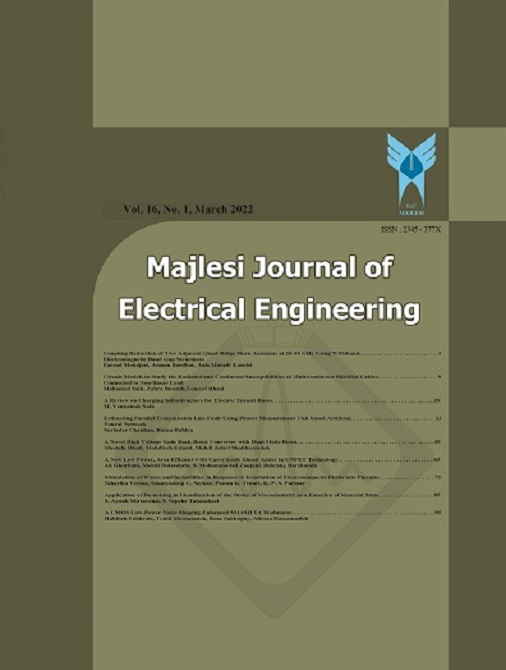Document Type : Reseach Article
Authors
- Cempaka Amalin Mahadzir 1
- Ahmad Fateh Mohamad Nor 1
- Siti Amely Jumaat 1
- Noor Syahirah Ahmad Safawi 2
1 Green and Sustainable Energy Focus Group, Faculty of Electrical and Electronic Engineering, University Tun Hussein Onn Malaysia (UTHM), Batu Pahat, Johor, Malaysia.
2 Hyper E-Mech Sdn Bhd, Johor Bahru, Malaysia.
Abstract
This paper focuses on utilizing an Artificial Neural Network (ANN) to predict photovoltaic (PV) panel output power. Since solar power output is fluctuating and depends on climatic, geographical and temporal factors, precise prediction requires the implementation of computational approaches. The aim of this research is to develop ANN algorithms that anticipate solar power output and enhance the structure of them by incorporating the derating factor due to dirt (kdirt) into account. The effectiveness and dependability of the ANN are determined using MATLAB software. By comparing the Mean Squared Error (MSE) of four different values of derating factor due to dirt which are 0.8, 0.88, 0.9 and 0.98 in ANN predictions comprehend with 4 input layers and 10 hidden layers. Direct data input is obtained through a photovoltaic solar panel at University Tun Hussein Onn Malaysia (UTHM). Comparative analysis also has been carried out after the
results has been obtained from the mathematical equations. The daily solar power output predictions are effectively achieved by the deployed ANN. As the result, the optimal kdirt has been selected which is 0.8 based on its ability to produce the most accurate ANN predictions than the other values of kdirt.
Keywords
- Kumar, Sunil, and Kavita Rathore. "Renewable Energy for Sustainable Development Goal of Clean and Affordable Energy." International Journal of Materials Manufacturing and Sustainable Technologies, 2 (1), 1–15. DOI: https://doi.org/10.56896/IJMMST.2023.2.1.001
- Yekinni, Sanusi, et al. “Solar Photovoltaic Energy System’’. Nanogenerators and Self-Powered Systems, IntechOpen, 24 May 2023. DOI: 10.5772/intechopen.108958
- Kashani, Marziyeh, et al. "The Optimization of Photovoltaic Systems Design Using Mathematical Modeling and QFD-DSM Methods." Majlesi Journal of Electrical Engineering2 (2022): 55-72. https://doi.org/10.30486/mjee.2022.696495
- seda.gov.my. (2020). FiT – Renewable Energy Malaysia. [online].
- Obaideen, Khaled, et al. "Solar energy: Applications, trends analysis, bibliometric analysis and research contribution to sustainable development goals (SDGs)." Sustainability 2 (2023): 1418. https://doi.org/10.3390/su15021418
- Putri, Raihan, et al. "Design and Implementation of a Solar Power System on Grid SDN 023905 BIN JAI using PVSYST Software." Majlesi Journal of Electrical Engineering3 (2023). https://doi.org/10.30486/mjee.2023.1989935.1167
- Setyawati, Harsasi, et al. "Photovoltaic Performance of Naphthol Blue Black Complexes and their Band Gap Energy." International Journal of Nanoelectronics and Materials2 (2023): 335-344 https://doi.org/10.58915/ijneam.v16i2.1232
- Ameur, Arechkik, et al. "Forecast modeling and performance assessment of solar PV systems."Journal of Cleaner Production 267 (2020): 122167. https://doi.org/10.1016/j.jclepro.2020.122167
- Mishra, Vijay Laxmi, Yogesh K. Chauhan, and Kripa S. Verma. "Various modeling approaches of photovoltaic module: A comparative analysis." Majlesi Journal of Electrical Engineering2 (2023): 117-131. 10.30486/mjee.2023.1984023.1109
- Nawab, Faisal, et al. "Solar irradiation prediction using empirical and artificial intelligence methods: A comparative review."Heliyon (2023). https://doi.org/10.1016/j.heliyon.2023.e17038
- Jamil, Wan Juzaili, et al. "Modeling of soiling derating factor in determining photovoltaic outputs." IEEE Journal of Photovoltaics5 (2020): 1417-1423. https://doi.org/10.1109/JPHOTOV.2020.3003815
- Liu, Shicheng, Ruidong Chang, Jian Zuo, Ronald J. Webber, Feng Xiong, and Na Dong. "Application of artificial neural networks in construction management: Current status and future directions."Applied Sciences 11, no. 20 (2021): 9616. https://doi.org/10.3390/app11209616
- Mahadzir, Cempaka Amalin, Ahmad Fateh Mohamad Nor, and Siti Amely Jumaat. "Photovoltaic Power Output Prediction using Graphical User Interface and Artificial Neural Network." Majlesi Journal of Electrical Engineering4 (2023): 73-78. https://doi.org/10.30486/mjee.2023.1995210.1243
- Nawab, Faisal, et al. "Solar irradiation prediction using empirical and artificial intelligence methods: A comparative review."Heliyon (2023). https://doi.org/10.1016/j.heliyon.2023.e17038
- Sustainable Energy Development Authority (SEDA MALAYSIA), “Fundamentals of Solar Photovoltaics Technology”. Chapter 5: Photovoltaic Technology, page 77. (2022). (ISBN 978-967-12390-7-0).
- Franklin, E. A. (2019). “Calculations for a Grid-Connected Solar Energy System.” University of Arizona Cooperative Extension: Tucson, AZ, USA, 2-6.
- Sara, Umme, Morium Akter, and Mohammad Shorif Uddin. "Image quality assessment through FSIM, SSIM, MSE and PSNR—a comparative study." Journal of Computer and Communications3 (2019): 8-18. https://doi.org/10.4236/jcc.2019.73002
- Mayer, M. J., & Gróf, G. (2021). “Extensive comparison of physical models for photovoltaic power forecasting.” Applied Energy, 283, 116239. https://doi.org/10.1016/j.apenergy.2020.116239

